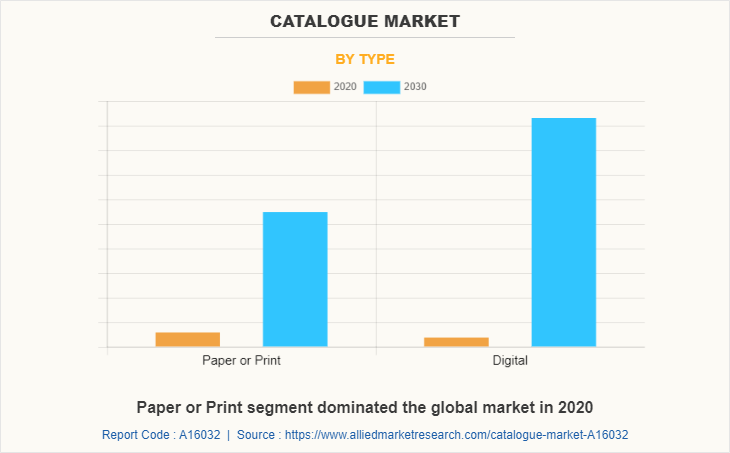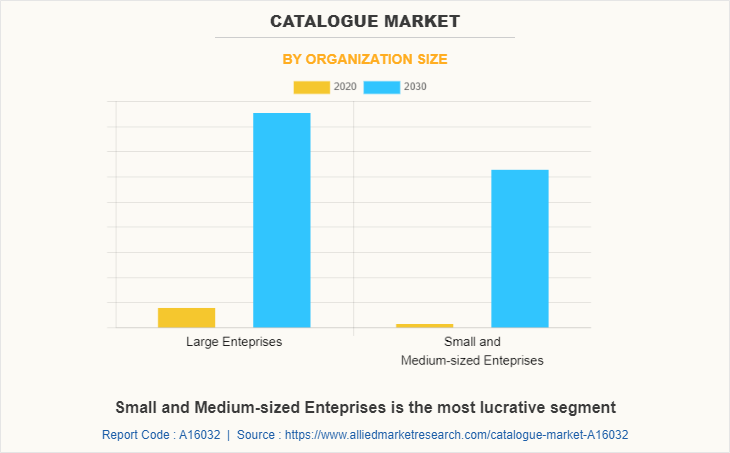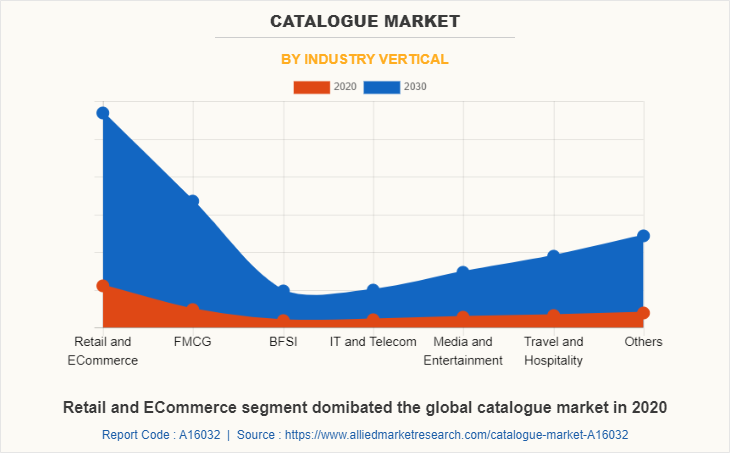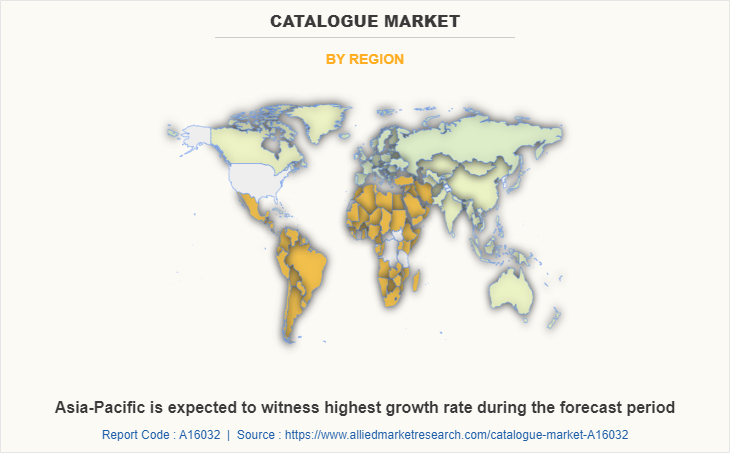Catalogue Market Research, 2030
The global catalogue market size was valued at $58.20 billion in 2020, and is projected to reach $335.62 billion by 2030, growing at a CAGR of 20.05% from 2021 to 2030.
The growth of the global catalogue market is driven by factors such as rise in penetration of smartphones coupled with strong internet access across the globe and surge in need to enhance customer experience & satisfaction. In addition, increase in use of catalogue marketing strategies in the retail & e-commerce sector is fostering the growth of the market.
However, rise in popularity of alternative marketing and advertising strategies is hampering the market growth. The growth of the global catalogue market is driven by factors such as rise in penetration of smartphones coupled with strong internet access across the globe and surge in need to enhance customer experience & satisfaction. In addition, increase in use of catalogue marketing strategies in the retail & e-commerce sector is fostering the growth of the catalogue market size. However, rise in popularity of alternative marketing and advertising strategies is hampering the market growth.

A catalogue is a type of marketing collateral that lists essential product details, which help buyers to make a purchase decision. These details include product features, descriptions, dimensions, price, weight, availability, color, and customer reviews. Catalogue is used in marketing as an effective method to motivate buyers and to show them what the company is offering.
Segment Review
The global catalogue market is segmented into type, organizational size, industry vertical, and region. Depending on type, the market is categorized into digital and print or paper. By organizational size, it is bifurcated into large enterprises and small & medium enterprises. On the basis of industry vertical, it is fragmented into BFSI, FMCG, retail & e-commerce, IT & telecom, media & entertainment, travel & hospitality, and others. Region wise, it is analyzed across North America, Europe, Asia-Pacific, and LAMEA.
On the basis of type, the paper or print segment dominated the catalogue market share in 2020. This is attributed to the fact that printed catalogues and brochures serve as the most powerful tools for the sales and marketing team, as they have all the vital information about the products or services. In addition, printed catalogue makes the visibility part of products easier and have lasting effect of it on customer mind. However, the digital segment is expected to witness highest growth rate during the forecast period. Digital catalogue increases brand awareness and has more range of clients than traditional catalogues.
Furthermore, the retail & e-commerce sector accepted digital transformation and digital technologies for more exposure and client satisfaction. Thus, these factors collectively are driving the adoption of digital catalogues globally. Moreover, increase in trend of online shopping and rise in number of global smartphone users foster the demand for digital catalogue.

By organization size, the large enterprises segment dominated the growth in the catalogue industry in 2020, and is expected to maintain its dominance during the forecast period. This is attributed to the fact that several products and services are offered in large-scale enterprises due to large base of customers, and it is important for these enterprises to keep products & services updated to analyze customer demand. In addition, surge in investments in marketing by large enterprises is expected to fuel the growth of the catalogue market.
However, the small & medium enterprises segment is expected to witness highest growth rate during the forecast period. Increase in cost-effectiveness of digital catalogue has fueled their adoption among SMEs. This is attributed to the fact that SMEs have low marketing budget and lack resources for high grade marketing; thus, they prefer adopting digital catalogue strategy to resolve complexities and improve cost optimization of business processes.

By industry vertical, retail & e-commerce segment dominated the catalogue industry in 2020, and is expected to maintain its dominance in the future. The characteristics of catalogues such as product exposure, detailed information, influence on buying decisions, wide reach, customer satisfaction, and lasting impression are escalating their demand in the retail & e-commerce sector, thus fostering the growth of the market. However, the FMCG segment is expected to witness highest growth rate during the forecast period.

North America dominated the catalogue market in 2020, and is expected to lead in the upcoming years, owing to surge in demand for digital catalogue among various verticals such as e-commerce, media & entertainment, and BFSI. However, Asia-Pacific is expected to register the highest growth during the forecast period, due to increase in number of smartphone users and rise in penetration of internet in the region. Moreover, many start-ups and new enterprises are heavily investing in catalogue marketing strategy in the region, which is anticipated to foster the catalog industry growth.

Top Impacting Factors
Increase in usage of catalogue marketing in retail & e-commerce sector
The adoption of catalogues is anticipated to increase considerably by retail & e-commerce vertical during the forecast period due to rise in use smartphones and strong internet access in emerging economies. Moreover, in the retail & e-commerce sector, the catalogue market trends such as online purchasing of products has escalated among customers in 2020; thus, digital catalogues gained high traction, which notably contributed toward the growth of the overall catalog industry.
In addition, catalogue marketing in retail & e-commerce helps in customer experience enhancement, choice efficiency, and offers clarity about products, as it provides detailed information and benefits of products. Furthermore, catalogues help retail & e-commerce sector to improve conversion rate, as they have more effect on the customer buying decisions and make purchasing decision effective. Thus, multiple benefits offered by catalogue in the retail & e-commerce sector is projected to foster the catalogue market growth.
Rise in demand for digital advertising and digital catalogue marketing in SMEs
Presently, increasing number of SMEs are investing in digital catalogue marketing, owing to the fact that it is an easy and quick way to share product information and respond to inbound customer enquiries for more information. In addition, SMEs are seeking for cost-effective advertising to reach thousands of potential customers with right strategy and application. Hence, online distribution and marketing of a digital catalogue has become prominent option for SMEs to expand their marketing reach via channels such as social media, search engines, catalogue websites, own website, email marketing, forums, blogger outreach, and online PR.
COVID-19 Impact Analysis
The global catalogue market was valued at $58.2 billion in 2020, and is projected to reach $335.62 billion by 2030, registering a CAGR of 20.05% from 2021 to 2030.The current estimation of 2030 is projected to be higher than pre-COVID-19 estimates. The COVID-19 impact has prompted companies and businesses to shift their business operations toward a remote working environment. In addition, the COVID-19 outbreak has brought changes in the way of shopping and marketing strategies.
The adoption of digital catalogue increased significantly during the global health crisis due to increase in sales of smartphones and work-from-home policy. Post COVID, the penetration of digital catalogues increased significantly, as they offer several advantages over print catalogues. The AMR studies predict that almost 69% of businesses have stopped printing catalogues within the past two to three years and have replaced them with online catalogues due to the convenience. Moreover, due to COVID-19, the sectors such as retail & e-commerce and media & entertainment adopted digitalization for smooth operations, which led to wide adoption of digital catalogues for marketing of products & services.
Key Benefits For Stakeholders
- This report provides a quantitative analysis of the market segments, current trends, estimations, and dynamics of the catalogue market analysis from 2020 to 2030 to identify the prevailing catalogue market opportunities.
- The market research is offered along with information related to key drivers, restraints, and opportunities.
- Porter's five forces analysis highlights the potency of buyers and suppliers to enable stakeholders make profit-oriented business decisions and strengthen their supplier-buyer network.
- In-depth analysis of the catalogue market segmentation assists to determine the prevailing market opportunities.
- Major countries in each region are mapped according to their revenue contribution to the global market.
- Market player positioning facilitates benchmarking and provides a clear understanding of the present position of the market players.
- The report includes the analysis of the regional as well as global catalogue market trends, key players, market segments, application areas, and market growth strategies.
Catalogue Market Report Highlights
| Aspects | Details |
| By Type |
|
| By Organization Size |
|
| By Industry Vertical |
|
| By Region |
|
| Key Market Players | FlippingBook, Publuu, Drawtify, Flipp Corp., Flipsnack, Akeneo |
Analyst Review
In accordance with the insights by the CXOs of leading companies, the global catalogue market is projected to witness prominent growth, especially in Asia-Pacific and Europe. This growth is attributed to high adoption of smartphones and rapid development of the retail & e-commerce sector due to penetration of internet.
According to the CXOs, in the digital era where computers and smartphones are monopolizing communication and life, there seems to be a comparatively less growth rate of traditional marketing than digital marketing. Moreover, studies have observed that printed catalogues and brochures might be one of the most powerful tools for a marketer; however, increasing number of SMEs as well as large enterprises are focusing on digital marketing in past few years.
Furthermore, rise in number of retailers is ceasing the catalogue production to improve businesses and reduce their impact on the environment. For instance, in May 2019, H&M, a Swedish multinational clothing company, announced to discontinue its catalogue business. The company further mentioned that the catalogues do not align with shopping behaviors from today's consumers. In past few years, printed catalogues have lost much of their appeal among marketers.
For instance, the Atlantic, an American magazine and multi-platform publisher, recently reported that the number of printed catalogues mailed in America peaked at 19 billion in 2007, and by 2018 had fallen to about 11.5 billion. This clearly indicated the declining growth rate of printed or physical catalogues. However, the global e-commerce sector is evolving, and increasing number of people are buying online. Hence, rise in number of companies inclining toward digital catalogues enables buyers to find specific product information in seconds. Such catalogues further help to create an immersive, information-rich experience for online shoppers and make them more likely to purchase the product.
On the other hand, during the COVID-19 pandemic, people stayed home to be safe, and therefore they had more discretionary income to spend on shopping online or via digital catalogue. In 2020, the catalogue market witnessed massive changes due to the COVID-19 pandemic, which completely altered the way consumers work, live, and shop for new products.
For instance, due to the proliferation of online advertising, companies were embracing digital catalogues as they engaged more consumers, made buying easier, and aligned with consumers’ environmental values. The CXOs further added that e-commerce companies are sending artificial intelligence (AI)-generated digital catalogues to stay relevant in their email marketing efforts. In addition, some of the e-commerce industry players are investing in direct-to-consumer channel or direct mail applications, as the digital space becomes increasingly crowded, while mailboxes are not full and have a more long-lasting effect.
Increase in demand for digital catalogue marketing & advertising strategies in small & medium enterprises (SMEs) is projected to be opportunistic for the growth of the global catalogue market
North America dominated the catalogue market in 2020, and is expected to lead in the upcoming years.
The catalogue has major applications in industry verticals such as Retail & e-commerce, FMCG, BFSI, IT & telecom, Media & entertainment, and Travel & hospitality
The global catalogue market was valued at $58.2 billion in 2020, and is projected to reach $335.62 billion by 2030, registering a CAGR of 20.05% from 2021 to 2030.
The global catalogue market is dominated by key players such as Akeneo, Bonial, DCatalog, Drawtify, Inc., Flipsnack, Flipp Corporation, FlippingBook, Publuu, ShopFully, and Tiendeo.
Loading Table Of Content...



